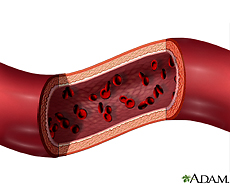 |
 |
 |
Other Health Topics:

-
Related Topics
-
Go Local
- Services and providers for Vasculitis in the U.S.
-
National Institutes of Health
- The primary NIH organization for research on Vasculitis is the National Institute of Allergy and Infectious Diseases
Vasculitis is an inflammation of the blood vessels. It happens when the body's immune system attacks the blood vessel by mistake. The cause is often unknown. Vasculitis can affect arteries, veins and capillaries. Arteries are vessels that carry blood from the heart to the body's organs. Veins are the vessels that carry blood back to the heart. Capillaries are tiny blood vessels that connect the small arteries and veins.
When a blood vessel becomes inflamed, it can
- Narrow, making it more difficult for blood to get through
- Close off completely so that blood can't get through
- Stretch and weaken so much that it bulges and may burst and cause dangerous bleeding inside the body
Symptoms of vasculitis can vary, but usually include fever, swelling and a general sense of feeling ill. The main goal of treatment is to stop the inflammation. Steroids and other medicines to stop inflammation are often helpful.
National Heart, Lung, and Blood Institute
-
Vasculitis
 (National Heart, Lung, and Blood Institute)
(National Heart, Lung, and Blood Institute)
-
Vasculitis
 (Patient Education Institute) - Requires Flash Player
(Patient Education Institute) - Requires Flash Player
Also available in Spanish
-
Vasculitis Syndromes of the Central and Peripheral Nervous Systems
 (National Institute of Neurological Disorders and Stroke) - Short Summary
(National Institute of Neurological Disorders and Stroke) - Short Summary
| Basics | Learn More | Multimedia & Cool Tools |
|---|---|---|
| Research | Reference Shelf | For You |
-
Overviews
-
JAMA Patient Page: Vasculitis(American Medical Association)
Also available in Spanish
- Vasculitis(Mayo Foundation for Medical Education and Research)
- Vasculitis Center: Frequently Asked Questions(Johns Hopkins Vasculitis Center)
-
JAMA Patient Page: Vasculitis(American Medical Association)
-
Diagnosis/Symptoms
-
Computed Tomography Angiography (CTA)(American College of Radiology, Radiological Society of North America)
Also available in Spanish
-
MR Angiography (MRA)(American College of Radiology, Radiological Society of North America)
Also available in Spanish
-
Ultrasound - Vascular(American College of Radiology, Radiological Society of North America)
Also available in Spanish
- What Is Vasculitis: Diagnosis(Johns Hopkins Vasculitis Center)
- What Is Vasculitis: Symptoms(Johns Hopkins Vasculitis Center)
-
Computed Tomography Angiography (CTA)(American College of Radiology, Radiological Society of North America)
-
Treatment
- Prednisone(Johns Hopkins Vasculitis Center)
- Vasculitis Treatments(Johns Hopkins Vasculitis Center)
-
Specific Conditions
- Buerger's Disease(Mayo Foundation for Medical Education and Research)
- Central Nervous System Vasculitis(Johns Hopkins University)
- Churg-Strauss Syndrome(Johns Hopkins Vasculitis Center)
- Cryoglobulinemia(Johns Hopkins Vasculitis Center)
- Microscopic Polyangiitis(Johns Hopkins Vasculitis Center)
- Polyarteritis Nodosa(Johns Hopkins Vasculitis Center)
- Rheumatoid Vasculitis(Johns Hopkins Vasculitis Center)
- Takayasu's Arteritis(Johns Hopkins University)
-
Related Issues
- Immune System and Its Link to Rheumatic Diseases(American College of Rheumatology)
- Vascular Pain(Cleveland Clinic Foundation)
- Vasculitis and Lupus(Lupus Foundation of America)
-
Tutorials
-
Vasculitis(Patient Education Institute) - Requires Flash Player
Also available in Spanish
-
Vasculitis(Patient Education Institute) - Requires Flash Player
-
Anatomy/Physiology
- Atlas of the Body: The Circulatory System -- Arterial(American Medical Association)
- Atlas of the Body: The Circulatory System -- Venous(American Medical Association)
-
Clinical Trials
-
ClinicalTrials.gov: Mucocutaneous Lymph Node Syndrome
 (National Institutes of Health)
(National Institutes of Health)
-
ClinicalTrials.gov: Vasculitis
 (National Institutes of Health)
(National Institutes of Health)
-
ClinicalTrials.gov: Mucocutaneous Lymph Node Syndrome
-
Journal Articles
References and abstracts from MEDLINE/PubMed (National Library of Medicine)
- Article: Antineutrophil cytoplasmic autoantibody-associated vasculitis in older patients.
- Article: Nocardiosis in adult-onset Still's disease and vasculitis syndrome.
- Article: New interpretation of vasculitis in the light of evolution.
- Vasculitis -- see more articles
-
Dictionaries/Glossaries
- What Is Vasculitis: Glossary of Terms(Johns Hopkins Vasculitis Center)
-
Directories
- AVF Member Directory(American Venous Forum)
-
Organizations
- American Autoimmune Related Diseases Association
-
National Heart, Lung, and Blood Institute

-
National Institute of Allergy and Infectious Diseases

-
National Institute of Neurological Disorders and Stroke

Also available in Spanish
-
Children
-
Henoch-Schönlein Purpura
 (National Kidney and Urologic Diseases Information Clearinghouse)
(National Kidney and Urologic Diseases Information Clearinghouse)
- Kawasaki Disease(Mayo Foundation for Medical Education and Research)
-
Kawasaki Disease
 (National Heart, Lung, and Blood Institute)
(National Heart, Lung, and Blood Institute)
-
Henoch-Schönlein Purpura
| Home | Health Topics | Drugs & Supplements | Encyclopedia | Dictionary | News | Directories | Other Resources | |
| Disclaimers | Copyright | Privacy | Accessibility | Quality Guidelines U.S. National Library of Medicine, 8600 Rockville Pike, Bethesda, MD 20894 National Institutes of Health | Department of Health & Human Services |
Date last updated: 18 September 2008 Topic last reviewed: 04 June 2008 |






